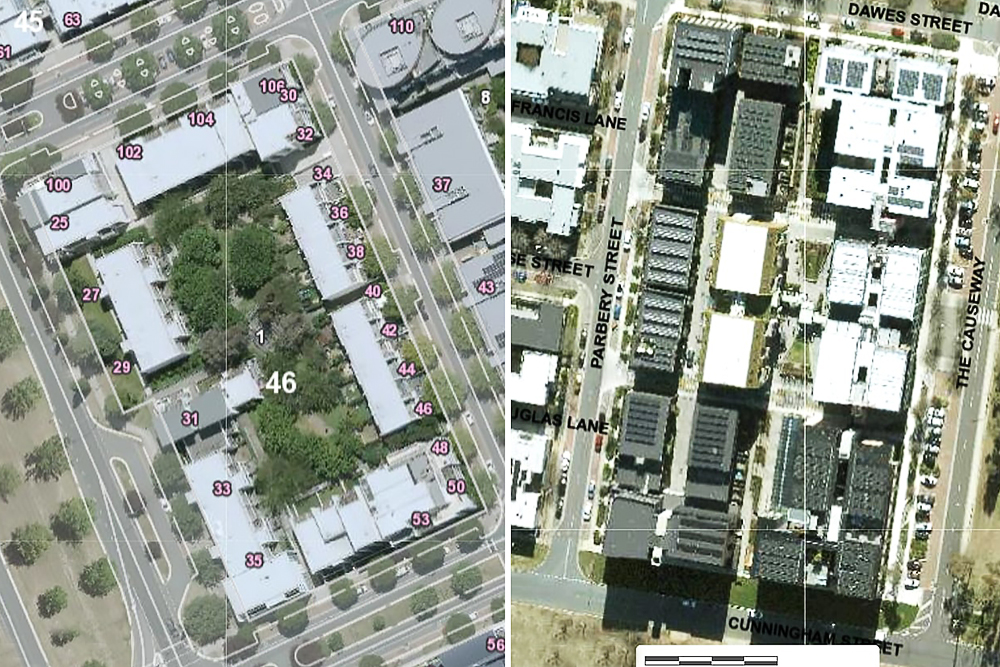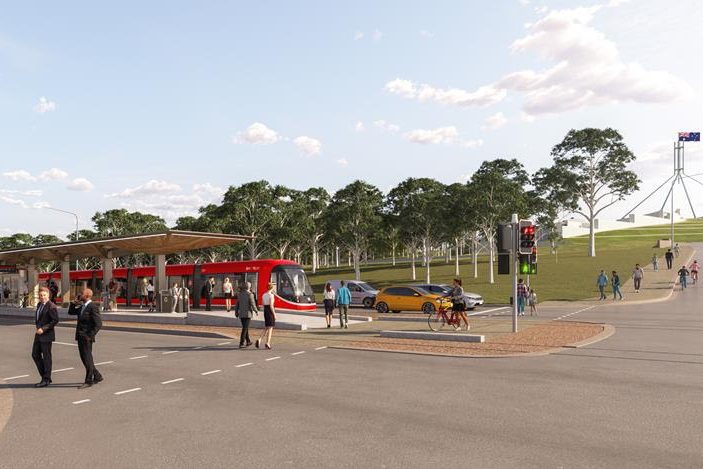
By Richard Johnston and Mervyn Dorrough
We seem to have lost sight of the importance of generous open space and landscaping with large, shade trees in more recent residential development in Canberra.
The major challenge now for urban designers is, as laid down in Canberra’s Living Infrastructure Plan: Cooling the City (2019): better preparing the city for and being more resilient to climate change.
The key goals of this plan are to by 2045 achieve:
- 30 per cent tree canopy cover (or “equivalent”); and
- 30 per cent permeable surfaces.
This applies to public spaces and private blocks, and suggests that the built-on area of future development needs to be more limited than in recent examples, and much more attention needs to be paid to substantial communal open space with good landscape design.
Internal courtyards can have an important role in responding to climate but also in building community. European cities have been doing this for centuries and there are some wonderful, more recent, medium-density examples in Barcelona and even more northern cities such as Vienna.
We used to do this sort of thing in Canberra. Some of the public housing complexes of the ’70s feature large communal courtyards with big trees and meeting and play spaces to encourage the interaction of residents. There were also some good private redevelopments done in Canberra, 30 or 40 years ago. Several were built under NCDC redevelopment guidelines which favoured block amalgamation for larger sites, enabling reasonable dwelling densities with generous communal open space.
If well designed and provided with appropriate facilities these central open spaces are well used, particularly by families and kids playing after school, in a safe place within sight of home, instead of having their own private backyards or no play space at all apart from adjacent streets and the few public parks.

The example in the left-hand picture is one of the first on the Kingston Foreshore, when it was run by a dedicated development authority. Regrettably more recent projects on the Foreshore have tended to higher densities and no large, shade trees, as the government and developers have sought to maximise their financial returns.
A very good, new example of integrating buildings & landscape for reducing urban heating and providing social benefits is the approved scheme for 403 dwellings on a derelict site at 1 Dairy Road Fyshwick by the Molonglo Group. This has:
- Lots of open space with a central lineal water feature.
- Four-storey, L-shaped buildings grouped to form semi-private “courtyards”.
- Vehicular circulation and visitor parking areas confined to under the buildings and on the perimeter of the site, allowing deep-rooted tree planting in the open space areas.
This project was also the subject of a “Microclimate Assessment” report, which is called for in the Living Infrastructure Plan and which the government said would become mandatory for major projects, but the promised guideline document is yet to emerge.
The objective is no net heat gain with new development. This study for Dairy Road indicated that the main contributors to heat reduction would be:
- At least 30 per cent site area to be canopy area of shade trees. Extensive permeable ground surfaces including rain gardens and wetlands.
- Appropriate location of open space and buildings (courtyard layout) for good solar orientation and climate moderation.
Wouldn’t this be a great model for the East Lake “urban renewal” area, which the government claims will be an “exemplary” project?
However, we see little sign yet that the government has learned any lessons from the tendency to overdevelop and eliminate large, shade trees from leased sites over the last two decades.
Richard Johnston is an architect and town planner, formerly a senior executive in the ACT Planning and Land Authority.
Mervyn Dorrough is a landscape architect, former director of Redbox Design Group, and was involved in major projects such as Parliament House, New Acton and the Kingston Foreshore.
Who can be trusted?
In a world of spin and confusion, there’s never been a more important time to support independent journalism in Canberra.
If you trust our work online and want to enforce the power of independent voices, I invite you to make a small contribution.
Every dollar of support is invested back into our journalism to help keep citynews.com.au strong and free.
Thank you,
Ian Meikle, editor




![Evie Hudson is a woman with amnesia, who forgets the last 13 years. Piecing her life back together, she navigates the harsh realities of coercive control.
Evie is the leading character in local author @emmagreyauthor's second novel Pictures of You.
Her debut book, The Last Love Note, sold more than 100,000 books worldwide within a few months of being published last year.
“I think that using amnesia really helped [show the effects of coercive control] because she had that sense of being completely lost in her own life,” Emma says of her new work of fiction.
To read the full story and find out more about this fabulous local author and her latest novel, visit our website at citynews.com.au or click the link in our bio! 📚✒️
#canberra #local #canberralocals #canberralife #australia #author #localauthor #Picturesofyou #coercivecontrolisabuse #dvawareness #bestsellingauthor #canberraauthor #localnews #citynews](https://citynews.com.au/wp-content/plugins/instagram-feed/img/placeholder.png)
Leave a Reply